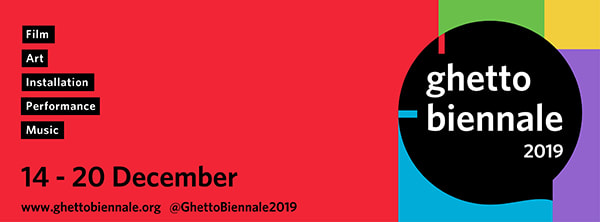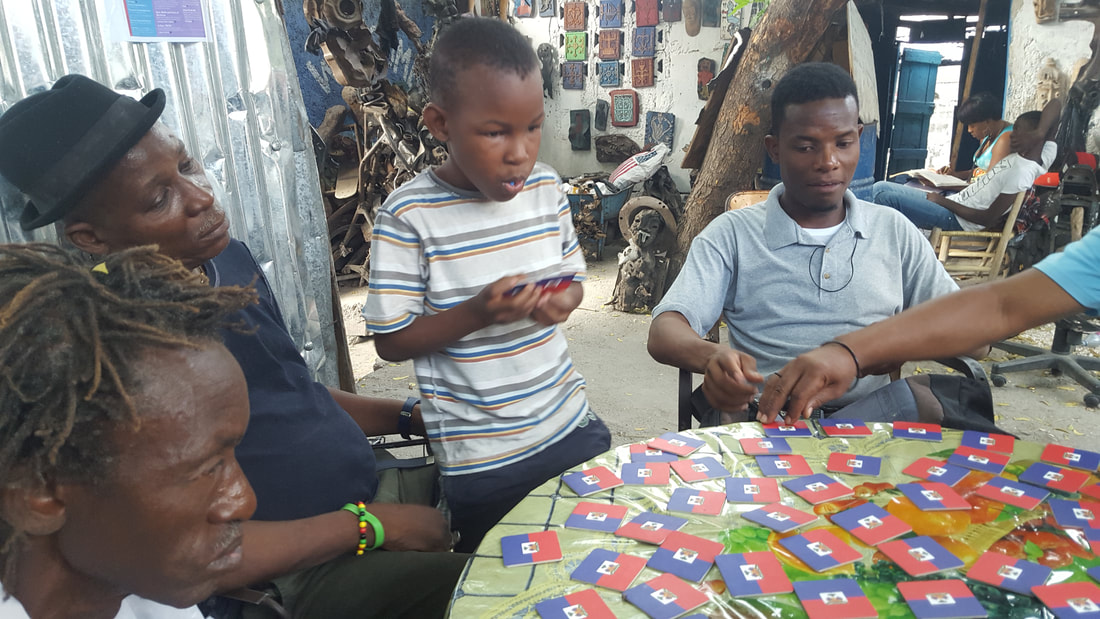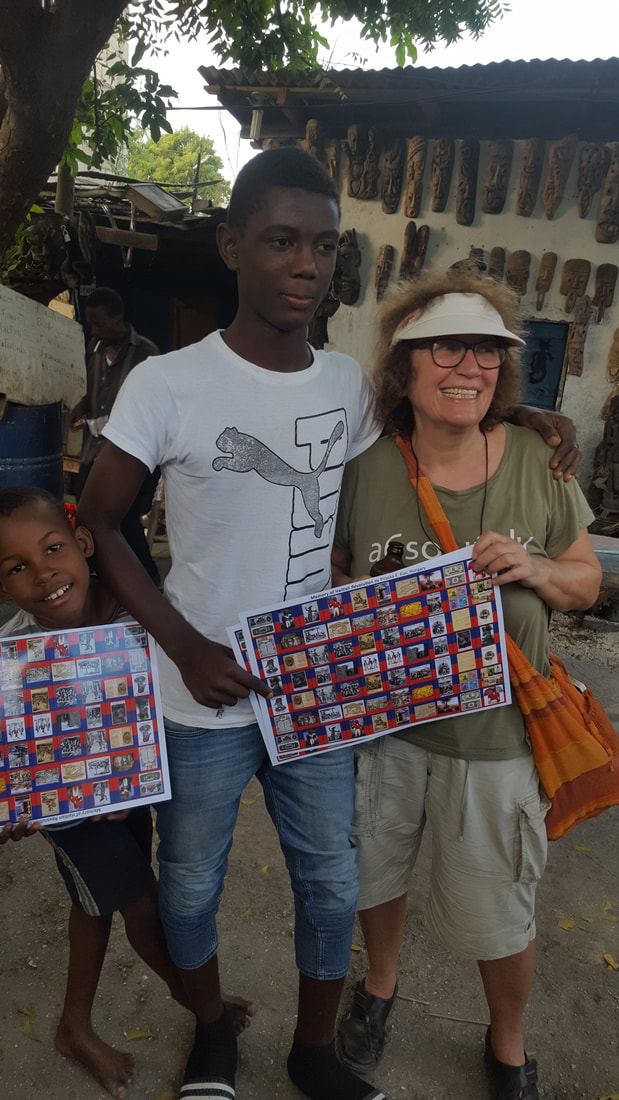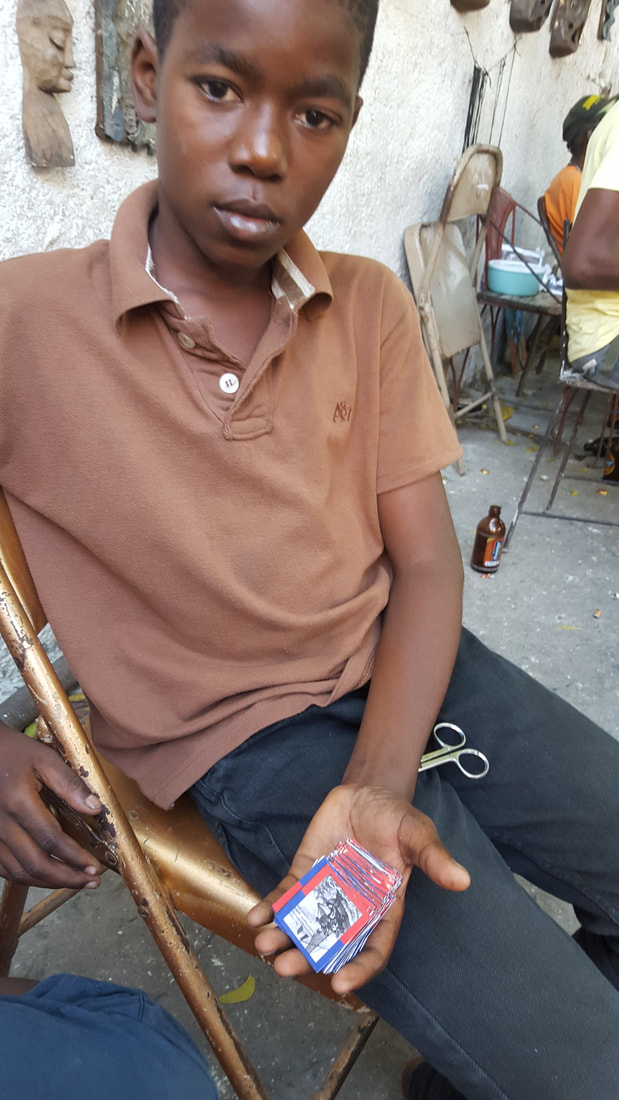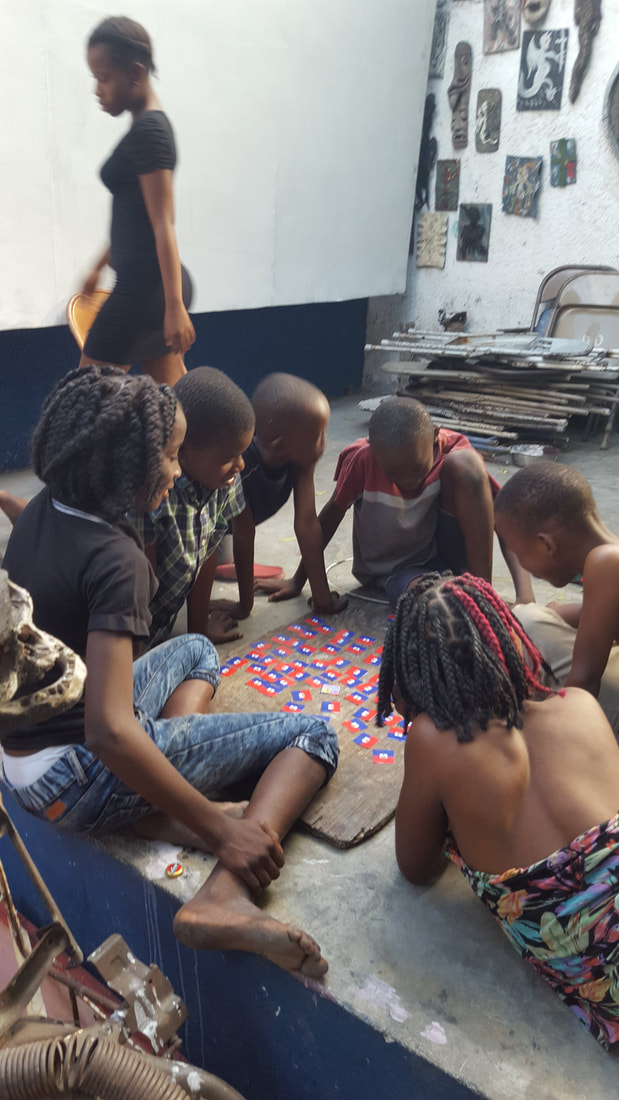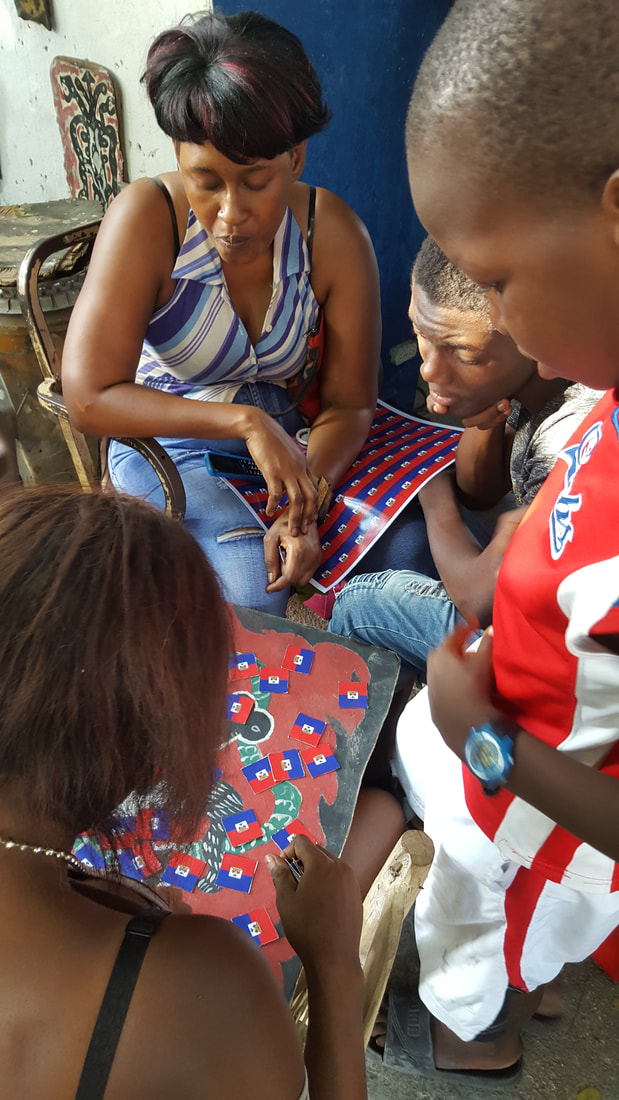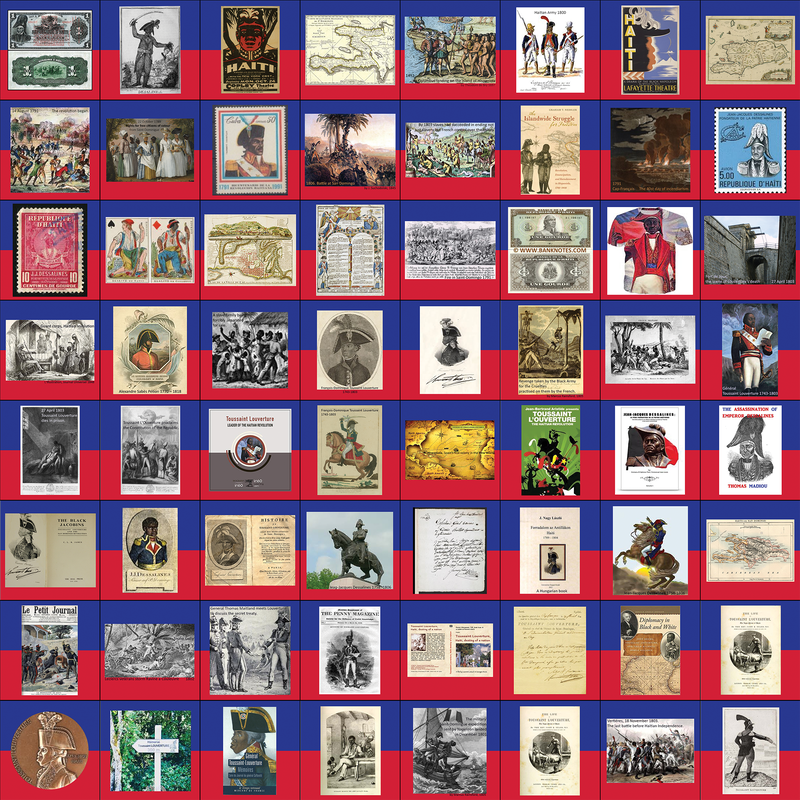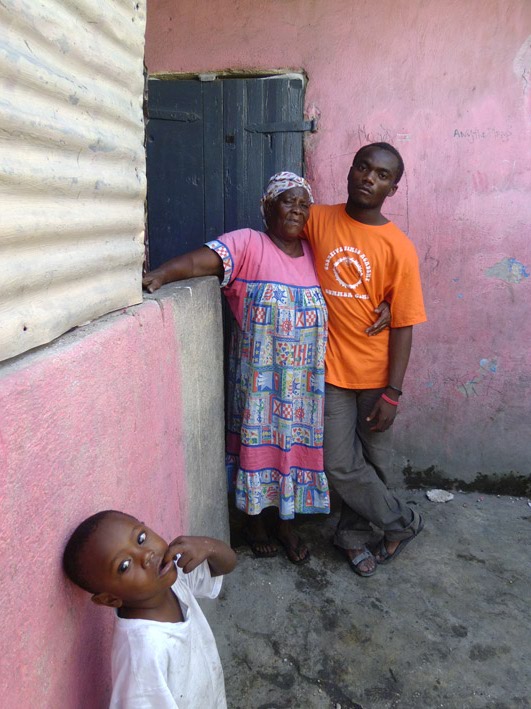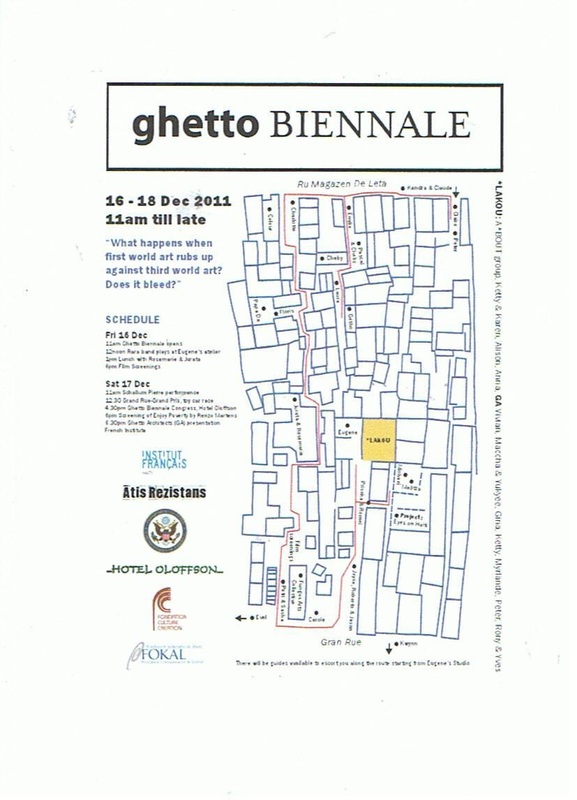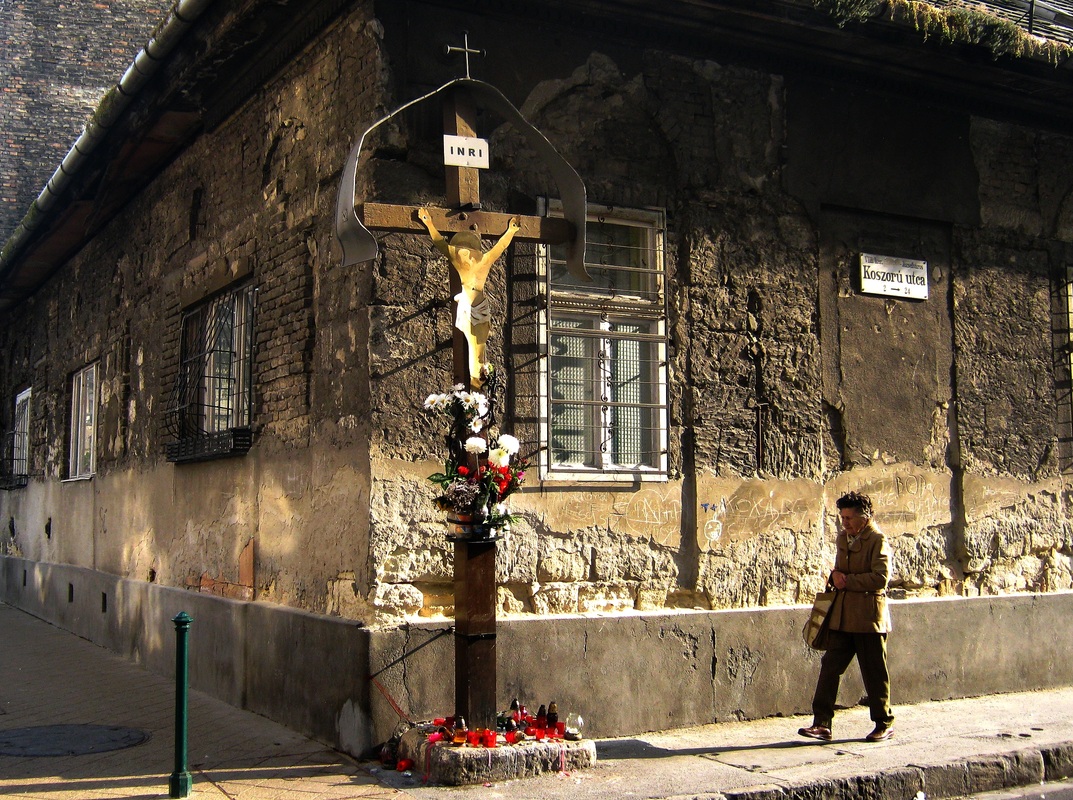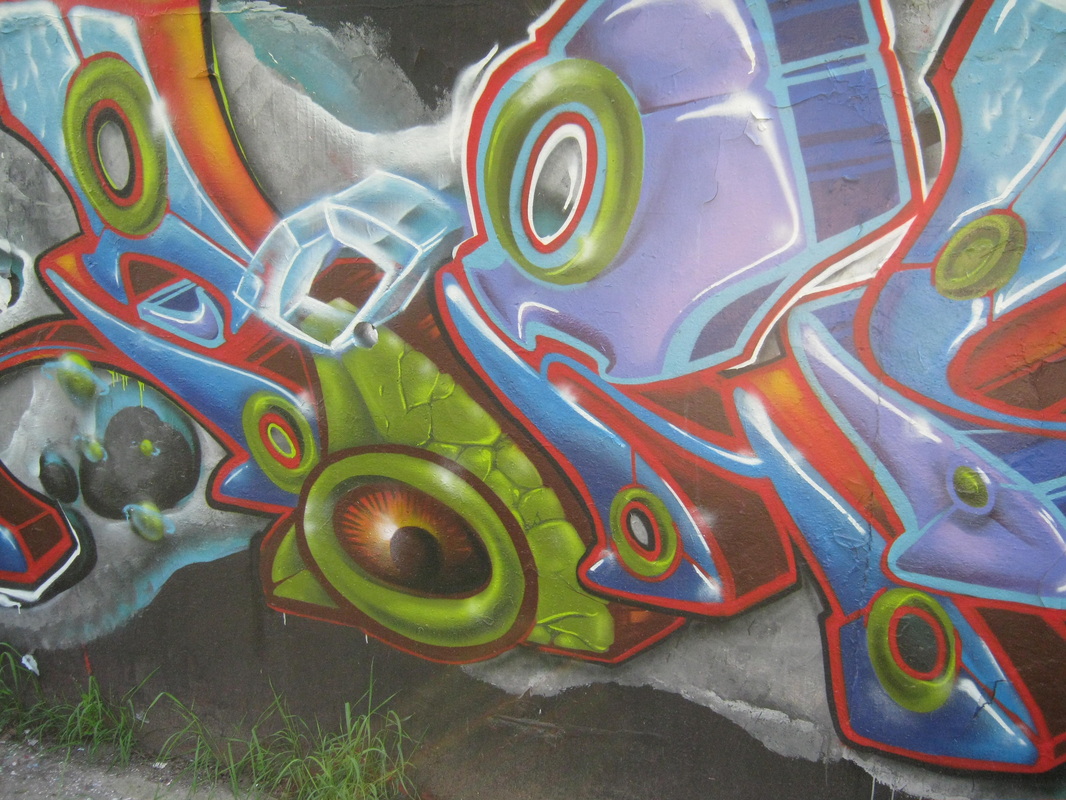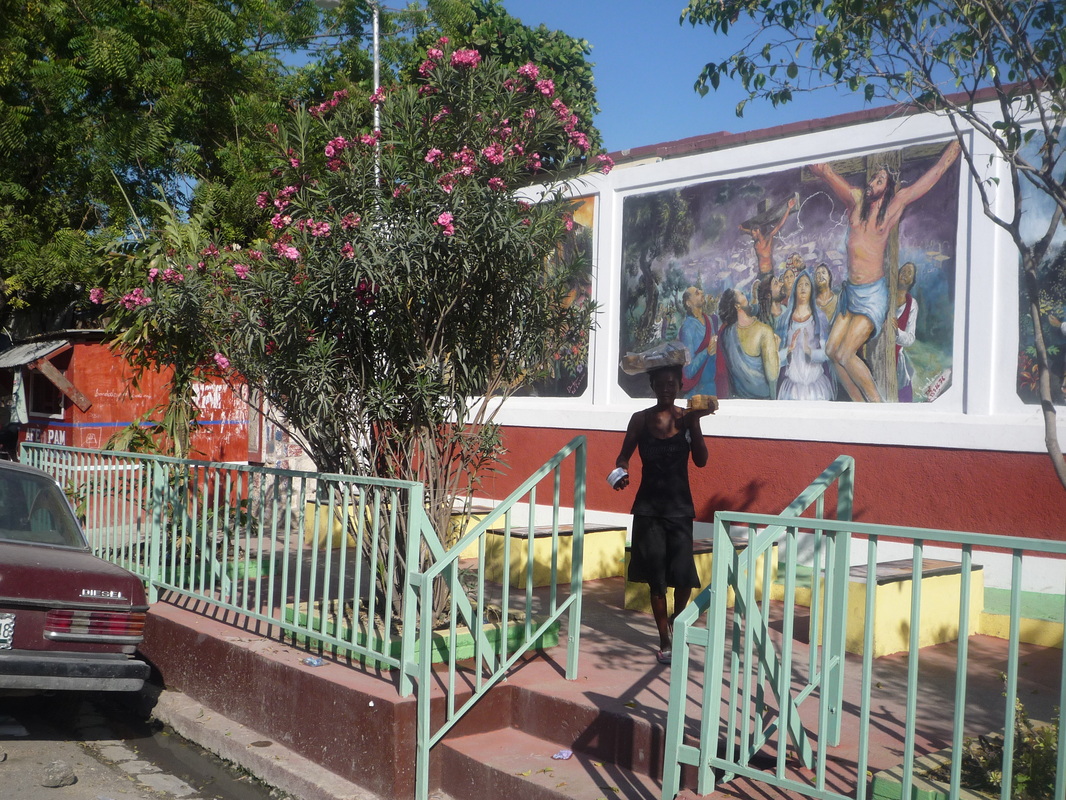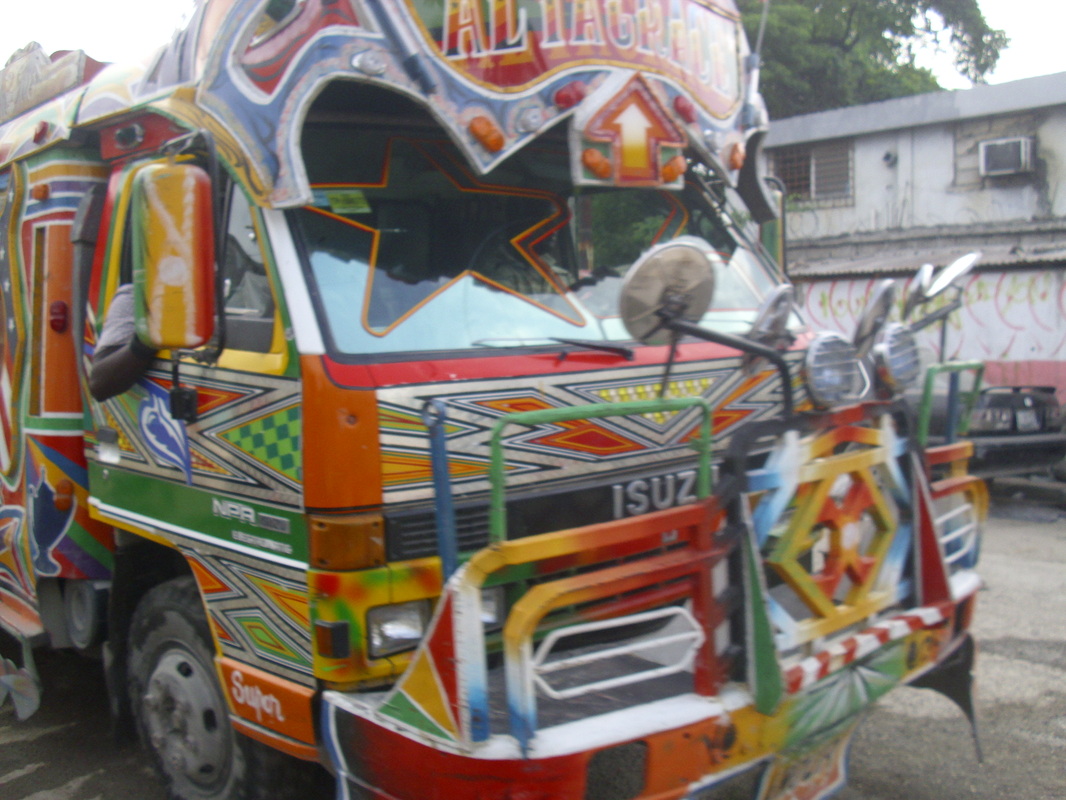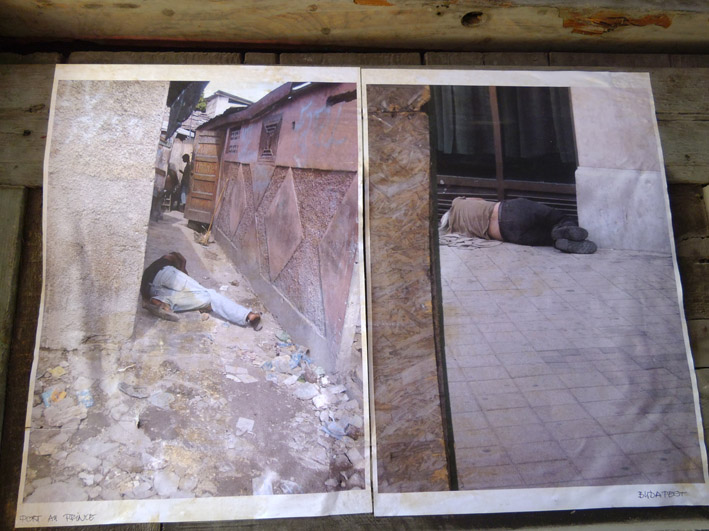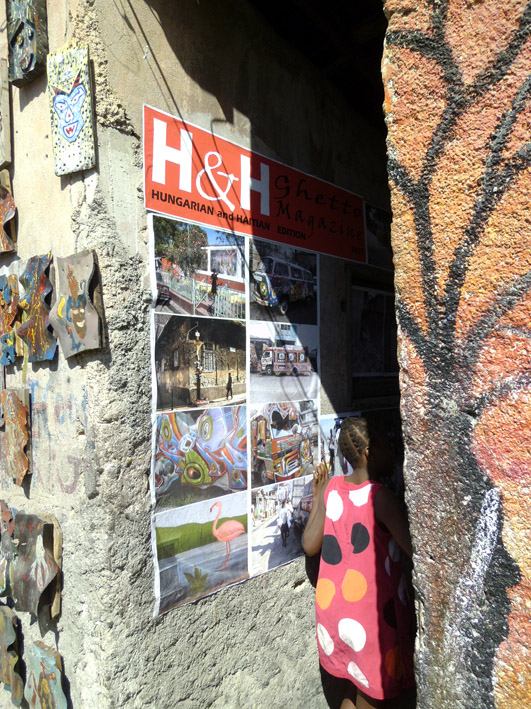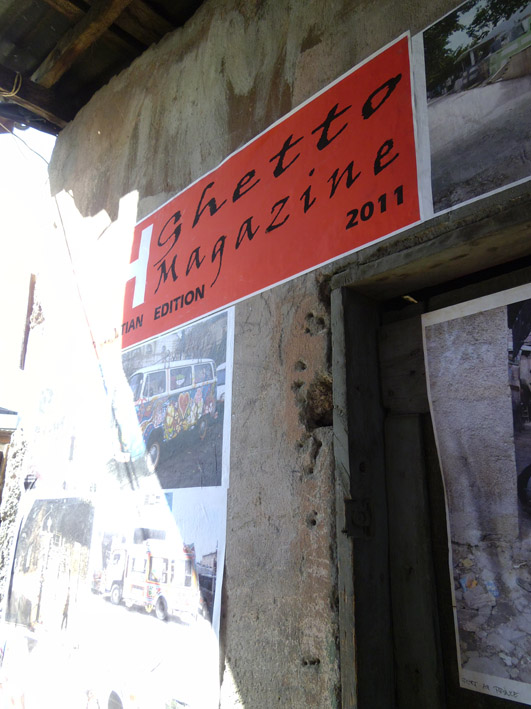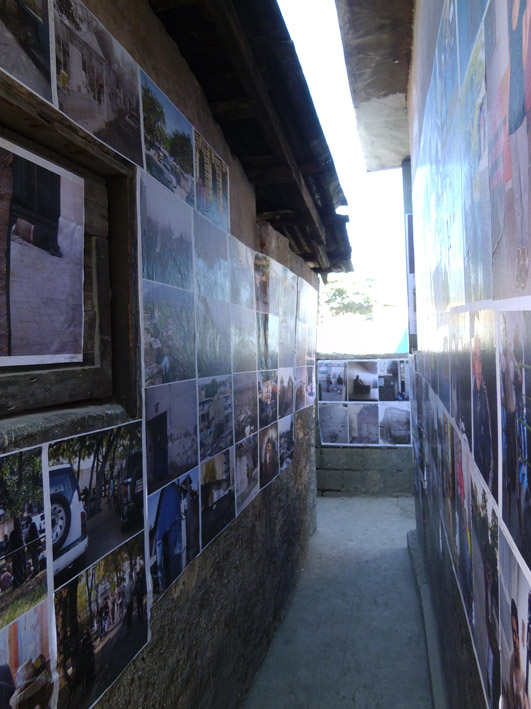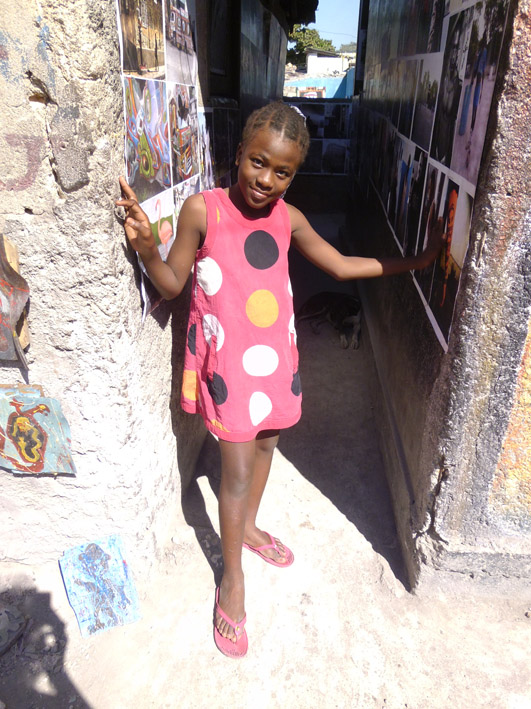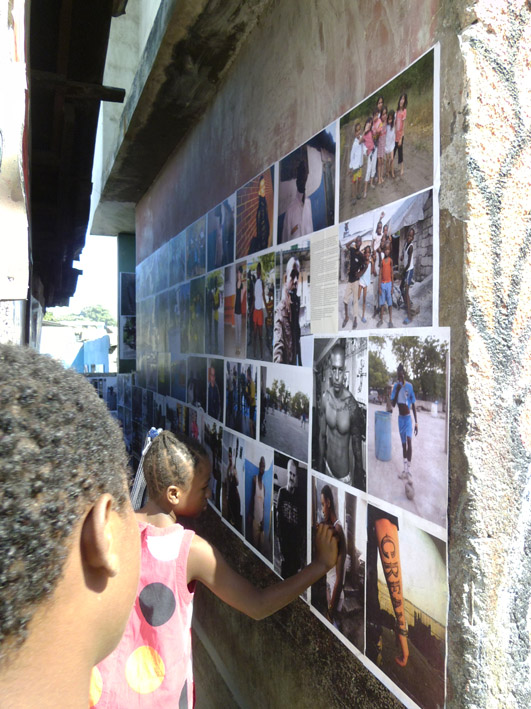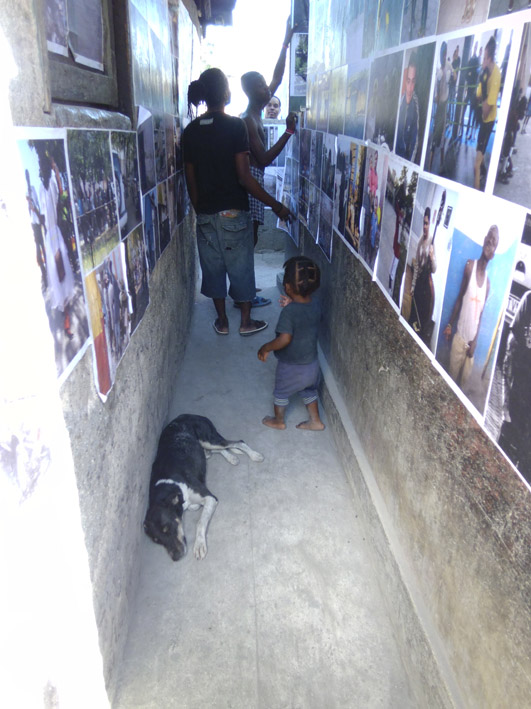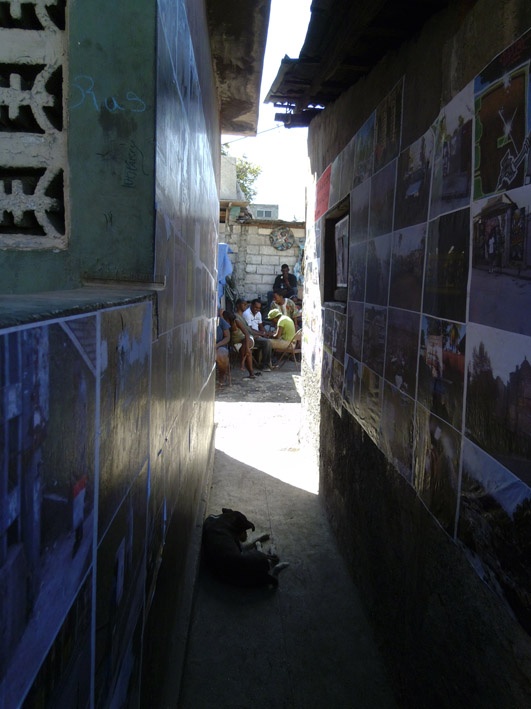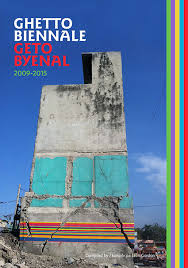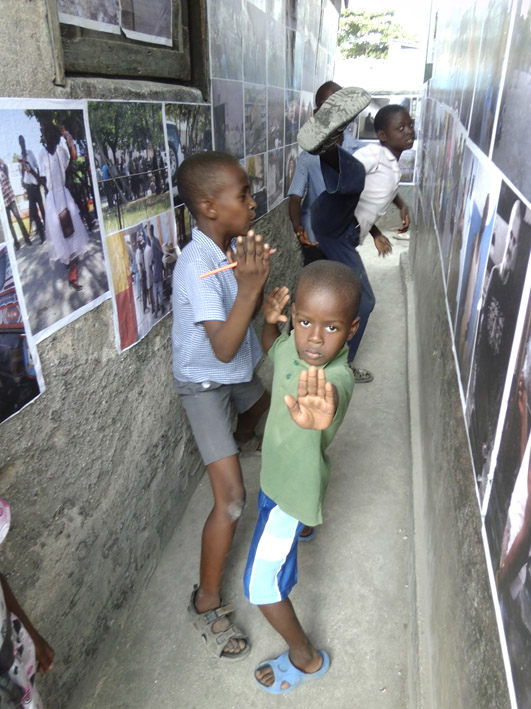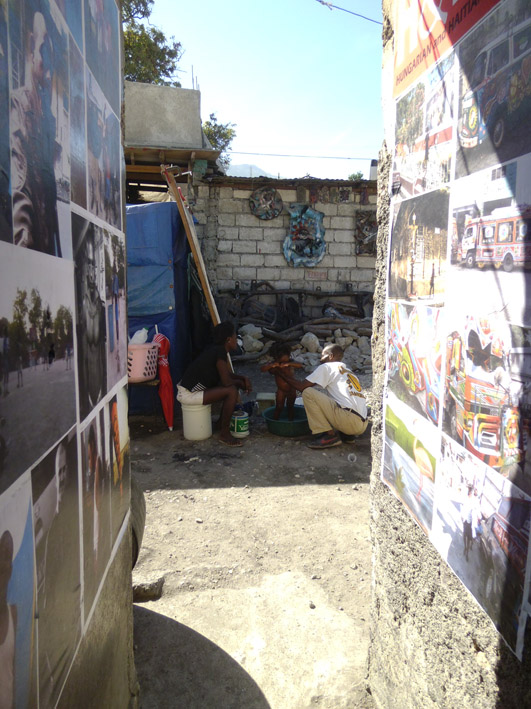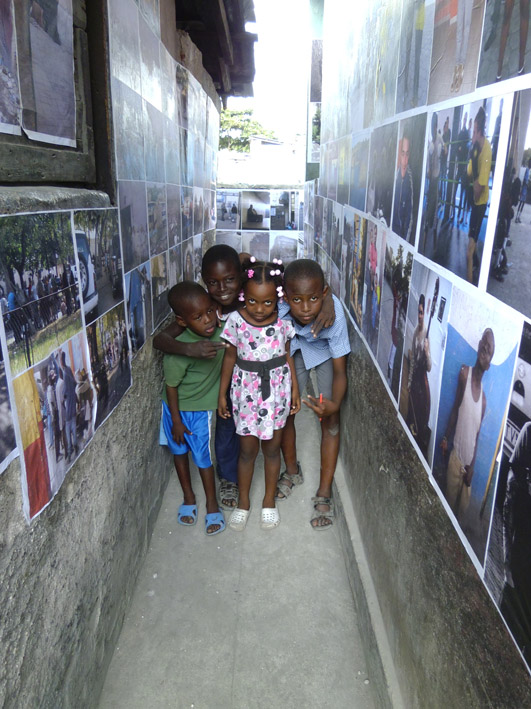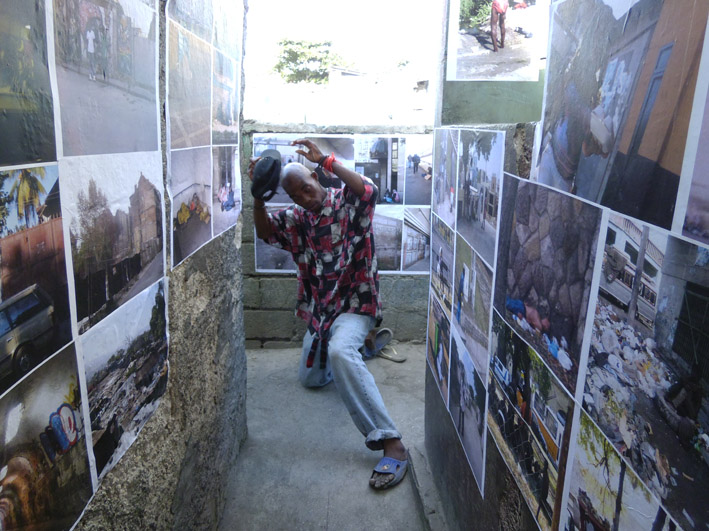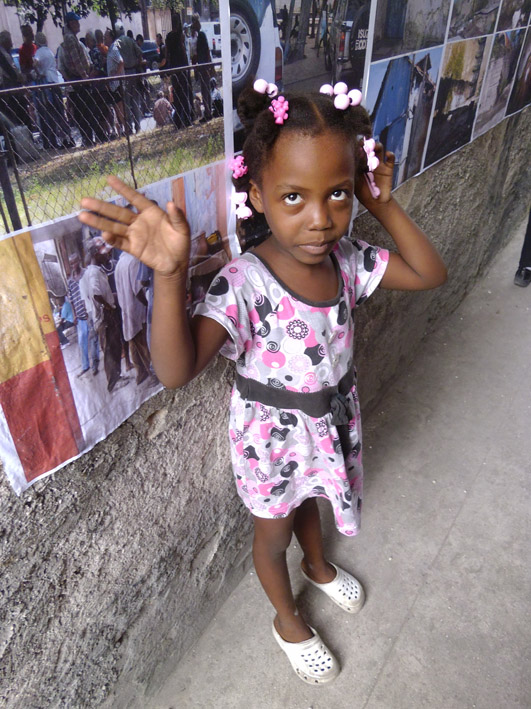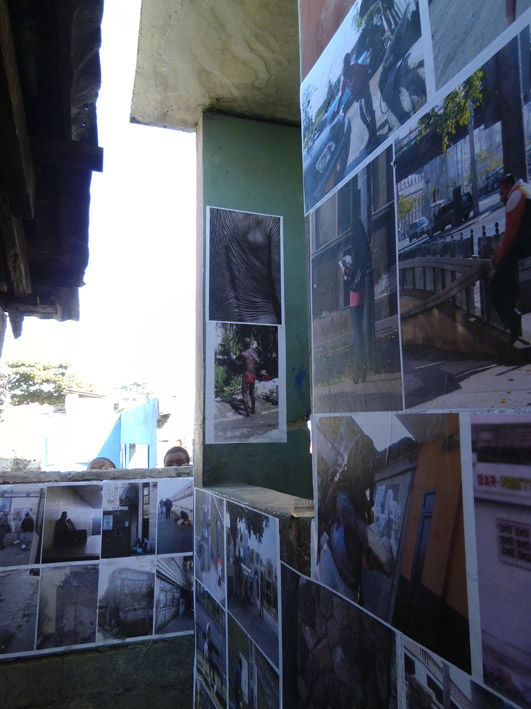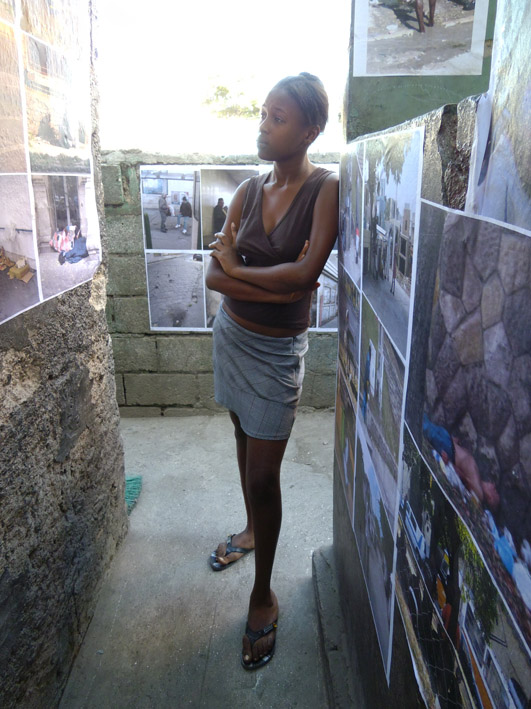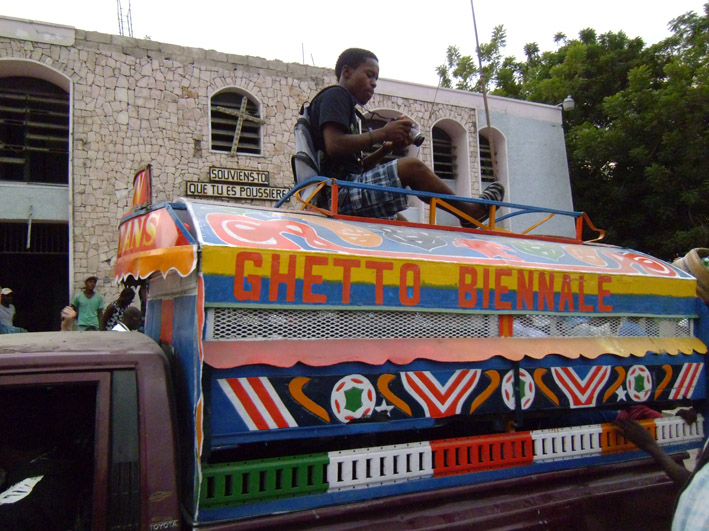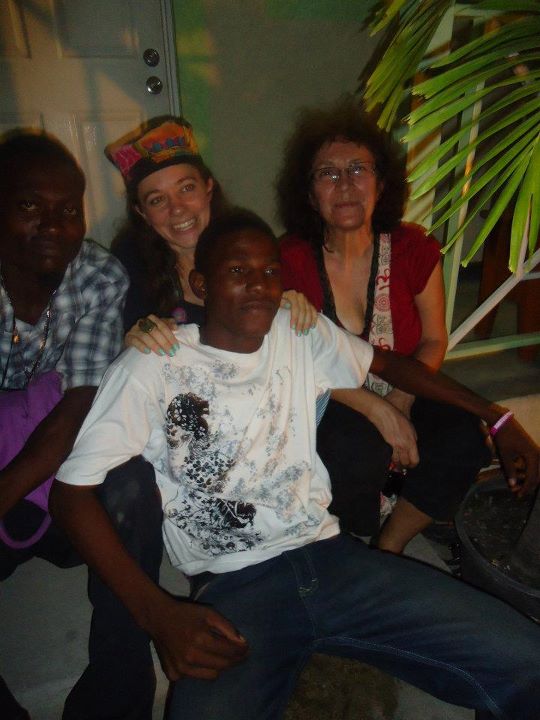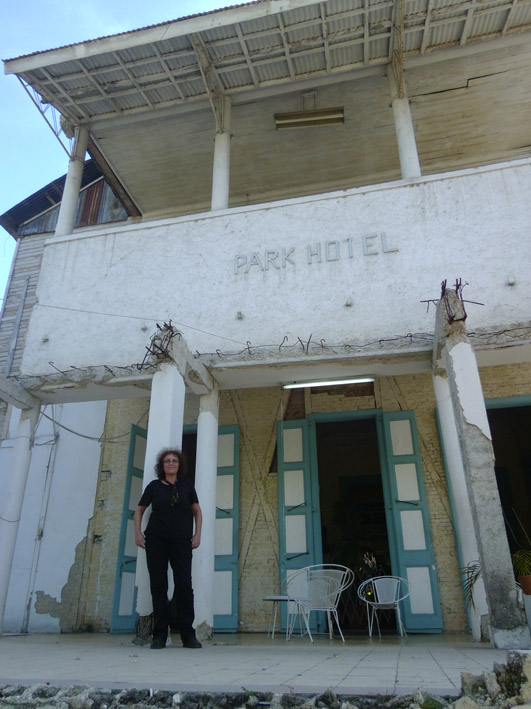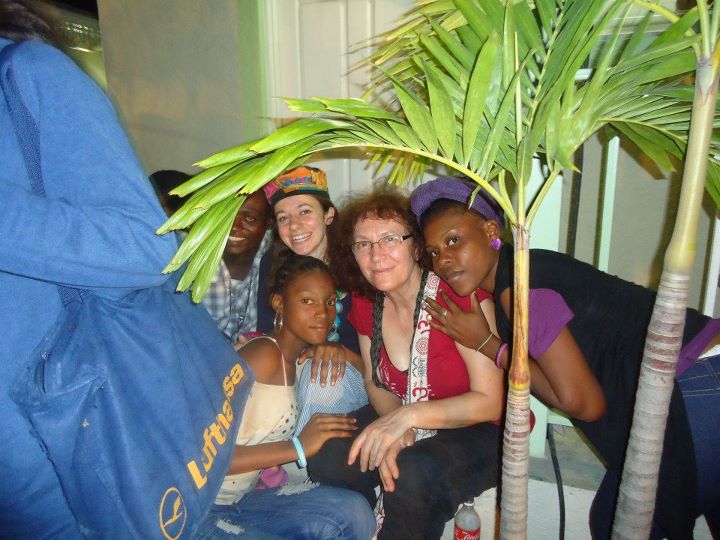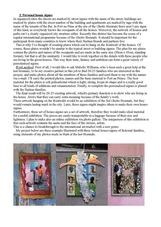Piroska E.Kiss
6th Ghetto Biennale
Memory of Haitian Revolution by Piroska É.Kiss, Hungary
A good way to learn much about the Haitian revolution and to memorize this knowledge is to play a game about the Haitian revolution.
I envision a memory game where you need to match pairs of cards. Playing is very simple - you turn over one card and then try to find a matching card. There are 32 pairs of pictures about Haitian history, mostly the Haitian revolution.
The background of all cards shows the colors of the Haitian flag and the back side of all cards is the Haitian flag.
I plan to prepare a big size set of the memory game to be realized it in Port au Prince during the first days. Late, the participants can play with this memory set. An exciting party around a big table builds the community.
I would like to print many pages with a small size version of this memory game for the children and adults who want to play at home. They can cut the cards, and then use the set.
5th Ghetto Biennale
| mapping_haitian_games_text.docx | |
| File Size: | 15 kb |
| File Type: | docx |
| piroska_é_kiss_acceptance_artists.pdf | |
| File Size: | 212 kb |
| File Type: | |
Ghetto Déjá vu, 2011
Romel Jean Pierre and his grandmother
Ghetto déjá vu
I am deeply committed to the problems of poverty and ghetto life - that is why I wanted to take part in the 2nd Ghetto Biennale.
Hungarian proverty has also created its ghettos, which are mostly inhabited by Gipsies. Despite a different standard of poverty, a different climate, different habits, etc, I think the athmosphere of hopelessness, the people living there, the objects created by them, and the art emerging there are similar in Hungarian and Haitian ghettos.
My project involves a series of photos showing the similarities, matching situations, scenes and moments. I sent many photos from Hungarian ghettos to a Haitian colleague, Romel Jean Pierre, who looked for the equivalents of my pictures in Port-au-Prince. Then he sent me ghetto photos whose equivalents I tryed to find in Budapest. We have continued this coupling of pictures till the beginning of the Biennale. I wanted to create a strong form of exhibiting those pictures on the walls of an alleyway. So we organized the pictures into the form of a tabloid.
H&H Ghetto Magazine / Hungarian and Haitian edition, 2011
“Columns”:
Environment Streets, squares, cemeteries
Houses, gates, courtyards Street art
Life on ruins among the ruins of the earthquake,
among the ruins left by World War II,
the passing time, and neglection
Homeless life
Social life, social events
Relationships, love, family
Community life in the street, gangs
Food distribution, relief
Leisure and entertainment
Fashion
Career: Ways out (learning, jobs, art, sports)
Dead-end ways (alcohol, drogs, crime,
prostitution, begging)
Many thanks for Romel's work. He has made wonderfur photos. I hope we'll continue the work!
I am deeply committed to the problems of poverty and ghetto life - that is why I wanted to take part in the 2nd Ghetto Biennale.
Hungarian proverty has also created its ghettos, which are mostly inhabited by Gipsies. Despite a different standard of poverty, a different climate, different habits, etc, I think the athmosphere of hopelessness, the people living there, the objects created by them, and the art emerging there are similar in Hungarian and Haitian ghettos.
My project involves a series of photos showing the similarities, matching situations, scenes and moments. I sent many photos from Hungarian ghettos to a Haitian colleague, Romel Jean Pierre, who looked for the equivalents of my pictures in Port-au-Prince. Then he sent me ghetto photos whose equivalents I tryed to find in Budapest. We have continued this coupling of pictures till the beginning of the Biennale. I wanted to create a strong form of exhibiting those pictures on the walls of an alleyway. So we organized the pictures into the form of a tabloid.
H&H Ghetto Magazine / Hungarian and Haitian edition, 2011
“Columns”:
Environment Streets, squares, cemeteries
Houses, gates, courtyards Street art
Life on ruins among the ruins of the earthquake,
among the ruins left by World War II,
the passing time, and neglection
Homeless life
Social life, social events
Relationships, love, family
Community life in the street, gangs
Food distribution, relief
Leisure and entertainment
Fashion
Career: Ways out (learning, jobs, art, sports)
Dead-end ways (alcohol, drogs, crime,
prostitution, begging)
Many thanks for Romel's work. He has made wonderfur photos. I hope we'll continue the work!
My exhibition was built in a path of Port au Prince.
Ghetto Biennale 2009 - 2015, Edited by Leah Gordon in London, 2017
Caribbean InTransit
http://issuu.com/caribbeanintransit/docs/issue_2_caribbean_intransit_location_and_caribbean#download
Mousse Magazine http://moussemagazine.it/articolo.mm?id=814
Frieze http://www.frieze.com/issue/review/2nd-ghetto-biennale/
Black Atlantic Resource
http://blackatlanticresource.wordpress.com/2012/02/17/a-salon-des-refuses-for-the-21st-century/
http://issuu.com/caribbeanintransit/docs/issue_2_caribbean_intransit_location_and_caribbean#download
Mousse Magazine http://moussemagazine.it/articolo.mm?id=814
Frieze http://www.frieze.com/issue/review/2nd-ghetto-biennale/
Black Atlantic Resource
http://blackatlanticresource.wordpress.com/2012/02/17/a-salon-des-refuses-for-the-21st-century/
3rd Ghetto Biennale - Proposal
As it started:
Concept and proposal
Piroska É. Kiss - stage and costume designer, architect
I am deeply committed to the problems of poverty and ghetto life - hence, the program of the 2nd Ghetto Biennale 2011 and my participation in it are immensely important for me.
Poverty, and the increasingly hopeless segregation of the poor is one of the worst social problems in Hungary, as well, which has been further aggravated by the current economic crisis. Although Hungary has not been afflicted by a catastrophy comparable to the earchquake in Haiti, still, it has been hit by several natural disasters, among them floods, landslides, storms and an extremely serious industrial catastrophy,the burst of the dam of a reservoir of red sludge.
I submit two projects.
1. Ghetto déjá vu
Hungarian proverty has also created its ghettos, which are mostly inhabited by Gipsies. Although, as far as I know, Haitian poverty surpasses that attested in our ghettos, I assume that the athmosphere of hopelessness, the people living there, the objects created by them, and the art emerging there are very similar.
My project involves a series of photos showing the similarities, matching situations, scenes, moments (a ghetto child, woman, man, a ghetto dog, cat, a ghetto vehicle, a ghetto street, house, courtyard, garbage, ghetto crime, hunger, dependence, disease, ghetto community, neighborhood, love, game, ghetto music, dance, graffiti).
The process of realizing the project: I send a Hungarian ghetto photo to a Haitian colleague, who looks for the equivalent of my picture in Port-au-Prince, then he/she sends me a ghetto photo, whose equivalent I will find in Budapest. We would continue this coupling of pictures until the beginning of the Biennale, so that the pictures can be exhibited during the Biennale on the wall of a house.
So as to realize my plan, I would have to establish contacts with an artist living in Port-au-Prince that is interested in the project and is willing to collaborate with me. I would need your help in finding him/her.
2. Waiting for Godot
In every age and in every situation, Beckett’s play, Waiting for Godot, is about the problems and the mental state of the given community. The first performance of Waiting for Godot in which I worked in Hungary in the nineteen seventies reflected the shared experience of desperation for both the artists and the spectators. If we participate in a theater performance that deeply affects our common and personal lives then there is a good change of catharsis arising, which is one of the most moving community experiences.
I cannot think of a more authentic site for Godot than the ghetto, and nobody can better understand Godot as the ghetto inhabitants.
My project is creating a performance of Waiting for Godot in Port-au Prince, performed by the inhabitants of the ghetto, in ghetto environments. It must be wonderful when the tree botched from ghetto garbage grows leaves by the 2nd act!
I envision the creation of the performance in the following way: The performance takes place in the ghetto, at a site that is busy but is still approproate for rehearsals, hopefully amongst the attention of the inhabitants. The prompter gives the text to the amateur actors sentence by sentence. The „object of exhibition” at the 2nd Ghetto Biennale 2011 is, on the one hand, the play performed during the Biennale, and, on the other hand, the film shot about the creative process, the performance, the actors, and the reaction of the ghetto audience.
Incidentally, if the project is realized, it might yield a film that can be sold to televisions, and the investment of a sponsor might bring some revenue.
21. 04. 2011 Piroska É.Kiss
I am deeply committed to the problems of poverty and ghetto life - hence, the program of the 2nd Ghetto Biennale 2011 and my participation in it are immensely important for me.
Poverty, and the increasingly hopeless segregation of the poor is one of the worst social problems in Hungary, as well, which has been further aggravated by the current economic crisis. Although Hungary has not been afflicted by a catastrophy comparable to the earchquake in Haiti, still, it has been hit by several natural disasters, among them floods, landslides, storms and an extremely serious industrial catastrophy,the burst of the dam of a reservoir of red sludge.
I submit two projects.
1. Ghetto déjá vu
Hungarian proverty has also created its ghettos, which are mostly inhabited by Gipsies. Although, as far as I know, Haitian poverty surpasses that attested in our ghettos, I assume that the athmosphere of hopelessness, the people living there, the objects created by them, and the art emerging there are very similar.
My project involves a series of photos showing the similarities, matching situations, scenes, moments (a ghetto child, woman, man, a ghetto dog, cat, a ghetto vehicle, a ghetto street, house, courtyard, garbage, ghetto crime, hunger, dependence, disease, ghetto community, neighborhood, love, game, ghetto music, dance, graffiti).
The process of realizing the project: I send a Hungarian ghetto photo to a Haitian colleague, who looks for the equivalent of my picture in Port-au-Prince, then he/she sends me a ghetto photo, whose equivalent I will find in Budapest. We would continue this coupling of pictures until the beginning of the Biennale, so that the pictures can be exhibited during the Biennale on the wall of a house.
So as to realize my plan, I would have to establish contacts with an artist living in Port-au-Prince that is interested in the project and is willing to collaborate with me. I would need your help in finding him/her.
2. Waiting for Godot
In every age and in every situation, Beckett’s play, Waiting for Godot, is about the problems and the mental state of the given community. The first performance of Waiting for Godot in which I worked in Hungary in the nineteen seventies reflected the shared experience of desperation for both the artists and the spectators. If we participate in a theater performance that deeply affects our common and personal lives then there is a good change of catharsis arising, which is one of the most moving community experiences.
I cannot think of a more authentic site for Godot than the ghetto, and nobody can better understand Godot as the ghetto inhabitants.
My project is creating a performance of Waiting for Godot in Port-au Prince, performed by the inhabitants of the ghetto, in ghetto environments. It must be wonderful when the tree botched from ghetto garbage grows leaves by the 2nd act!
I envision the creation of the performance in the following way: The performance takes place in the ghetto, at a site that is busy but is still approproate for rehearsals, hopefully amongst the attention of the inhabitants. The prompter gives the text to the amateur actors sentence by sentence. The „object of exhibition” at the 2nd Ghetto Biennale 2011 is, on the one hand, the play performed during the Biennale, and, on the other hand, the film shot about the creative process, the performance, the actors, and the reaction of the ghetto audience.
Incidentally, if the project is realized, it might yield a film that can be sold to televisions, and the investment of a sponsor might bring some revenue.
21. 04. 2011 Piroska É.Kiss
Answer of Getto Biennale Committee
A COPY OF THIS ACCEPTANCE WITH LETTERHEAD HAS BEEN ATTACHED AS A PDF WHICH CAN BE USED FOR FUNDING APPLICATIONS
Dear Piroska
Many thanks for your interest in the Ghetto Biennale and for taking the time to send us a proposal. We are very pleased to inform you that your proposal has been accepted for the 2nd Ghetto Biennale 2011. This is only for your project 'Ghetto Deja Vu' as the Wating for Godot feels a little too ambitious for us. We received a large number of innovative and carefully considered submissions. We had to make difficult decisions based on the limited places available, logistical resources, material feasibility and to ensure that the projects covered a broad palate of themes, forms and media. We are genuinely happy to offer you the chance to take part in the Ghetto Biennale. If you no longer wish to take part in the Ghetto Biennale please inform us immediately so we can assign you place to another project. You can access some research and budgeting information on the resources page of the 2nd Ghetto Biennale website. We will endeavour to update this information, especially in terms of prices for budgeting, regularly. But please do not hesitate to contact Leah Gordon at [email protected] for any particular precise information you may need. The Ghetto Biennale is due to take place between the dates 28th November until 18th December. Artists are not expected to be in Haiti for the entire time as we understand you may have economic restrictions, but the organisers will be on site during this period. We envisage an event displaying the works created during the process on 16th December and for all the artists to be present for a final conference on the 18th December. We encourage all participants to take part in both events. We will need to know the exact dates that you plan to arrive, number of people in your team and how long you plan to stay in Haiti as soon as possible so we can book a hotel room for you. The hotel owner has just confirmed that it is possible for a number of artists to camp in the hotel grounds for a much smaller daily fee, so if you wish to do take up this offer please let me know ASAP. We also need a fuller breakdown of your material, translation and additional labour needs (such as welding, carpentry, tailoring etc.) as soon as possible. This will give us the chance to fully assess your project and schedule with local amenities, people and services. We would like to put a list of participants onto the website with a short synopsis of your project, your website address and contact details. This will enable you to start making connections, cross-collaborations and organising potential equipment and room sharing. Could you please send us these details within the next ten days. If you do not want to appear on the website please inform us too. The Ghetto Biennale organisers do not accept any responsibility or liability for your personal safety, your possessions, artwork and equipment, or your health during your period in Haiti taking part in the Ghetto Biennale. We advise you to take out possessions and health insurance for the duration of your stay.
Kind Regards,
Ghetto Biennale Committee
Dear Piroska
Many thanks for your interest in the Ghetto Biennale and for taking the time to send us a proposal. We are very pleased to inform you that your proposal has been accepted for the 2nd Ghetto Biennale 2011. This is only for your project 'Ghetto Deja Vu' as the Wating for Godot feels a little too ambitious for us. We received a large number of innovative and carefully considered submissions. We had to make difficult decisions based on the limited places available, logistical resources, material feasibility and to ensure that the projects covered a broad palate of themes, forms and media. We are genuinely happy to offer you the chance to take part in the Ghetto Biennale. If you no longer wish to take part in the Ghetto Biennale please inform us immediately so we can assign you place to another project. You can access some research and budgeting information on the resources page of the 2nd Ghetto Biennale website. We will endeavour to update this information, especially in terms of prices for budgeting, regularly. But please do not hesitate to contact Leah Gordon at [email protected] for any particular precise information you may need. The Ghetto Biennale is due to take place between the dates 28th November until 18th December. Artists are not expected to be in Haiti for the entire time as we understand you may have economic restrictions, but the organisers will be on site during this period. We envisage an event displaying the works created during the process on 16th December and for all the artists to be present for a final conference on the 18th December. We encourage all participants to take part in both events. We will need to know the exact dates that you plan to arrive, number of people in your team and how long you plan to stay in Haiti as soon as possible so we can book a hotel room for you. The hotel owner has just confirmed that it is possible for a number of artists to camp in the hotel grounds for a much smaller daily fee, so if you wish to do take up this offer please let me know ASAP. We also need a fuller breakdown of your material, translation and additional labour needs (such as welding, carpentry, tailoring etc.) as soon as possible. This will give us the chance to fully assess your project and schedule with local amenities, people and services. We would like to put a list of participants onto the website with a short synopsis of your project, your website address and contact details. This will enable you to start making connections, cross-collaborations and organising potential equipment and room sharing. Could you please send us these details within the next ten days. If you do not want to appear on the website please inform us too. The Ghetto Biennale organisers do not accept any responsibility or liability for your personal safety, your possessions, artwork and equipment, or your health during your period in Haiti taking part in the Ghetto Biennale. We advise you to take out possessions and health insurance for the duration of your stay.
Kind Regards,
Ghetto Biennale Committee
